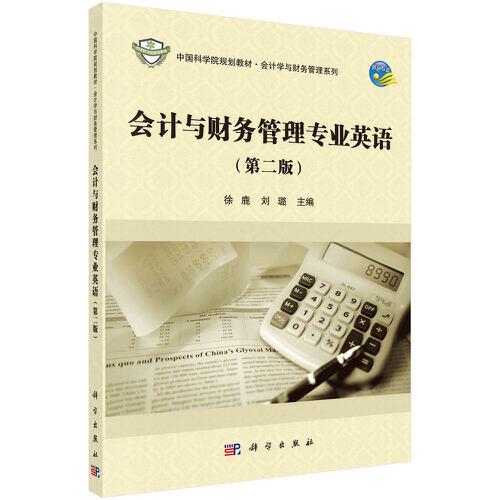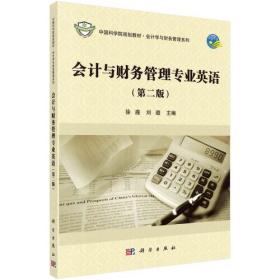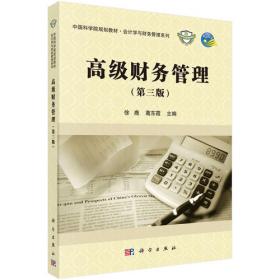会计与财务管理专业英语(第二版)
出版时间:
2021-01
版次:
1
ISBN:
9787030561220
定价:
58.00
装帧:
其他
页数:
367页
字数:
534千字
712人买过
-
《会计与财务管理专业英语(第二版)》涵盖了会计和财务管理的有关内容,分为两个部分,共28章。**部分是会计部分,分基础会计和财务会计两个单元,共16章。基础会计单元依次介绍了会计等式、会计循环和基本的财务报表知识;财务会计单元依次介绍了资产、负债、所有者权益、收入、费用和具体的财务报表应用。第二部分是财务管理专题,共12章,依次介绍了时间价值、利率、风险、融资、投资、营运资金、利润分配和报表分析等内容。每一章后面都附有词汇表。 Contents
PART 1 ACCOUNTING 1
UNIT 1 Basic Accounting 2
Chapter 1 Introduction to Accounting 3
1.1 Definition of Accounting 3
1.2 Profession of Accounting 3
1.3 Types of Accounting Information 5
1.4 Measurement Bases of Financial Accounting 5
1.5 Basic Accounting Assumptions and Qualitative Characteristics 7
Chapter 2 The Accounting Equation and Double-Entry Bookkeeping 17
2.1 Accounting Elements 17
2.2 The Accounting Equation 18
2.3 Double-Entry Bookkeeping 21
Chapter 3 Accounting Cycle (Ⅰ) 29
3.1 Journal and Journalizing Transactions 29
3.2 Ledger and Posting Transactions 32
3.3 Preparing a Trial Balance 35
Chapter 4 Accounting Cycle (Ⅱ) 43
4.1 Time Period Principle and the Need for Adjustments 43
4.2 Accrual Basis Versus Cash Basis of Accounting 44
4.3 Prepare Adjusting Entries 45
4.4 The Adjusted Trial Balance and Preparation for Financial Statements 49
4.5 Worksheet 52
4.6 Closing Entries 54
4.7 The Post-Closing Trial Balance 56
4.8 The Steps in the Accounting Cycle 57
Chapter 5 Basic Financial Statements 66
5.1 Statement of Profit or Loss and Other Comprehensive Incomes 66
5.2 Statement of Changes in Owners’ Equity 67
5.3 Statement of Financial Position 68
5.4 Statement of Cash Flows 70
Chapter 6 Accounting for Merchandising Operations 76
6.1 Merchandising Activities 76
6.2 Accounting for Merchandise Purchase 78
6.3 Accounting for Merchandise Sales 81
6.4 The Adjusting and Closing Entries for Merchandisers 83
6.5 Preparing Financial Statements 85
UNIT 2 Financial Accounting 93
Chapter 7 Cash 94
7.1 Nature of Cash 94
7.2 Control of Cash 95
Chapter 8 Accounts Receivable 110
8.1 Nature of Accounts Receivable 110
8.2 Sales Discounts 111
8.3 Sales Returns and Allowances 112
8.4 Accounting for Bad Debt Expense 112
Chapter 9 Inventory 126
9.1 Nature of Inventory 126
9.2 Perpetual and Periodic Inventory Systems 127
9.3 Inventory Cost Flow Methods 128
Chapter 10 Fixed Assets 140
10.1 Definition of Fixed Assets 140
10.2 Acquisition of Fixed Assets 140
10.3 Depreciation of Fixed Assets 142
10.4 Disposal of Fixed Assets 145
Chapter 11 Intangible Assets 152
11.1 Definition of Intangible Assets 152
11.2 Classification of Intangible Assets 152
11.3 Acquisition of Intangible Assets 153
11.4 Amortization of Intangible Assets 154
11.5 Goodwill 155
Chapter 12 Liabilities 161
12.1 Definition of Liabilities 161
12.2 Characteristics of Liabilities 161
12.3 Classification of Liabilities 161
12.4 Accounting for Liabilities 162
Chapter 13 Owners’ Equity 171
13.1 Forms of Business Organizations 171
13.2 Sole Proprietorship Accounting 171
13.3 Partnership Accounting 172
13.4 Corporation Accounting 182
Chapter 14 Revenues and Expenses 198
14.1 Contents of Income Statement 198
14.2 Accounting for Revenues 199
14.3 Accounting for Expenses 201
Chapter 15 Financial Statements (Ⅰ) 210
15.1 Statement of Financial Position 210
15.2 Statement of Profit or Loss and Other Comprehensive Incomes 219
Chapter 16 Financial Statements (Ⅱ) 233
16.1 Statement of Cash Flows 233
16.2 Statement of Changes in Owners’ Equity 237
PART 2 FINANCIAL MANAGEMENT 248
Chapter 17 Overview of Financial Management 250
17.1 Main Contents of Financial Management 250
17.2 Targets of Financial Management 253
17.3 Major Tasks of Financial Managers 254
Chapter 18 Time Value of Money 257
18.1 Relationship to Payment Decisions 257
18.2 Future Value and Present Value of Single Amount 257
18.3 Future Value and Present Value of Annuity 259
18.4 Determining Annuity Value 262
Chapter 19 Interest Rate 265
19.1 Historical Interest Rates 265
19.2 Reasons for Interest Rate Changes 266
19.3 Interest Rate Quotes 267
19.4 Converting APR to EAR 267
19.5 Inflation and Real Versus Nominal Rates 268
19.6 Risks and Taxes 268
19.7 Market Interest Rate Model 269
Chapter 20 Risk and Return 271
20.1 A Single Investment 271
20.2 A Multi-Investment Portfolio 273
20.3 Risk-Return Relationship 275
Chapter 21 Financial Ratio Analysis 278
21.1 Broad Categories of Ratios 278
21.2 Profitability and Return on Capital 280
21.3 Liquidity, Gearing/Leverage and Working Capital 282
21.4 Efficiency Ratios: Control of Receivables and Inventories 285
21.5 Shareholders’ Investment Ratios 287
Chapter 22 Debt Financing 296
22.1 Short-Term Debt Financing 296
22.2 Long-Term Debt Financing 297
Chapter 23 Equity Financing 301
23.1 The Concept of Equity Financing 301
23.2 Advantages and Disadvantages of Equity Financing 301
23.3 The Factors Considered for Choosing a Method of Financing 302
23.4 The Sources of Equity Financing 302
23.5 The Methods of Equity Financing 303
Chapter 24 Capital Budgeting (Ⅰ) 308
24.1 The Importance of Capital Budgeting 308
24.2 The Pro
-
内容简介:
《会计与财务管理专业英语(第二版)》涵盖了会计和财务管理的有关内容,分为两个部分,共28章。**部分是会计部分,分基础会计和财务会计两个单元,共16章。基础会计单元依次介绍了会计等式、会计循环和基本的财务报表知识;财务会计单元依次介绍了资产、负债、所有者权益、收入、费用和具体的财务报表应用。第二部分是财务管理专题,共12章,依次介绍了时间价值、利率、风险、融资、投资、营运资金、利润分配和报表分析等内容。每一章后面都附有词汇表。
-
目录:
Contents
PART 1 ACCOUNTING 1
UNIT 1 Basic Accounting 2
Chapter 1 Introduction to Accounting 3
1.1 Definition of Accounting 3
1.2 Profession of Accounting 3
1.3 Types of Accounting Information 5
1.4 Measurement Bases of Financial Accounting 5
1.5 Basic Accounting Assumptions and Qualitative Characteristics 7
Chapter 2 The Accounting Equation and Double-Entry Bookkeeping 17
2.1 Accounting Elements 17
2.2 The Accounting Equation 18
2.3 Double-Entry Bookkeeping 21
Chapter 3 Accounting Cycle (Ⅰ) 29
3.1 Journal and Journalizing Transactions 29
3.2 Ledger and Posting Transactions 32
3.3 Preparing a Trial Balance 35
Chapter 4 Accounting Cycle (Ⅱ) 43
4.1 Time Period Principle and the Need for Adjustments 43
4.2 Accrual Basis Versus Cash Basis of Accounting 44
4.3 Prepare Adjusting Entries 45
4.4 The Adjusted Trial Balance and Preparation for Financial Statements 49
4.5 Worksheet 52
4.6 Closing Entries 54
4.7 The Post-Closing Trial Balance 56
4.8 The Steps in the Accounting Cycle 57
Chapter 5 Basic Financial Statements 66
5.1 Statement of Profit or Loss and Other Comprehensive Incomes 66
5.2 Statement of Changes in Owners’ Equity 67
5.3 Statement of Financial Position 68
5.4 Statement of Cash Flows 70
Chapter 6 Accounting for Merchandising Operations 76
6.1 Merchandising Activities 76
6.2 Accounting for Merchandise Purchase 78
6.3 Accounting for Merchandise Sales 81
6.4 The Adjusting and Closing Entries for Merchandisers 83
6.5 Preparing Financial Statements 85
UNIT 2 Financial Accounting 93
Chapter 7 Cash 94
7.1 Nature of Cash 94
7.2 Control of Cash 95
Chapter 8 Accounts Receivable 110
8.1 Nature of Accounts Receivable 110
8.2 Sales Discounts 111
8.3 Sales Returns and Allowances 112
8.4 Accounting for Bad Debt Expense 112
Chapter 9 Inventory 126
9.1 Nature of Inventory 126
9.2 Perpetual and Periodic Inventory Systems 127
9.3 Inventory Cost Flow Methods 128
Chapter 10 Fixed Assets 140
10.1 Definition of Fixed Assets 140
10.2 Acquisition of Fixed Assets 140
10.3 Depreciation of Fixed Assets 142
10.4 Disposal of Fixed Assets 145
Chapter 11 Intangible Assets 152
11.1 Definition of Intangible Assets 152
11.2 Classification of Intangible Assets 152
11.3 Acquisition of Intangible Assets 153
11.4 Amortization of Intangible Assets 154
11.5 Goodwill 155
Chapter 12 Liabilities 161
12.1 Definition of Liabilities 161
12.2 Characteristics of Liabilities 161
12.3 Classification of Liabilities 161
12.4 Accounting for Liabilities 162
Chapter 13 Owners’ Equity 171
13.1 Forms of Business Organizations 171
13.2 Sole Proprietorship Accounting 171
13.3 Partnership Accounting 172
13.4 Corporation Accounting 182
Chapter 14 Revenues and Expenses 198
14.1 Contents of Income Statement 198
14.2 Accounting for Revenues 199
14.3 Accounting for Expenses 201
Chapter 15 Financial Statements (Ⅰ) 210
15.1 Statement of Financial Position 210
15.2 Statement of Profit or Loss and Other Comprehensive Incomes 219
Chapter 16 Financial Statements (Ⅱ) 233
16.1 Statement of Cash Flows 233
16.2 Statement of Changes in Owners’ Equity 237
PART 2 FINANCIAL MANAGEMENT 248
Chapter 17 Overview of Financial Management 250
17.1 Main Contents of Financial Management 250
17.2 Targets of Financial Management 253
17.3 Major Tasks of Financial Managers 254
Chapter 18 Time Value of Money 257
18.1 Relationship to Payment Decisions 257
18.2 Future Value and Present Value of Single Amount 257
18.3 Future Value and Present Value of Annuity 259
18.4 Determining Annuity Value 262
Chapter 19 Interest Rate 265
19.1 Historical Interest Rates 265
19.2 Reasons for Interest Rate Changes 266
19.3 Interest Rate Quotes 267
19.4 Converting APR to EAR 267
19.5 Inflation and Real Versus Nominal Rates 268
19.6 Risks and Taxes 268
19.7 Market Interest Rate Model 269
Chapter 20 Risk and Return 271
20.1 A Single Investment 271
20.2 A Multi-Investment Portfolio 273
20.3 Risk-Return Relationship 275
Chapter 21 Financial Ratio Analysis 278
21.1 Broad Categories of Ratios 278
21.2 Profitability and Return on Capital 280
21.3 Liquidity, Gearing/Leverage and Working Capital 282
21.4 Efficiency Ratios: Control of Receivables and Inventories 285
21.5 Shareholders’ Investment Ratios 287
Chapter 22 Debt Financing 296
22.1 Short-Term Debt Financing 296
22.2 Long-Term Debt Financing 297
Chapter 23 Equity Financing 301
23.1 The Concept of Equity Financing 301
23.2 Advantages and Disadvantages of Equity Financing 301
23.3 The Factors Considered for Choosing a Method of Financing 302
23.4 The Sources of Equity Financing 302
23.5 The Methods of Equity Financing 303
Chapter 24 Capital Budgeting (Ⅰ) 308
24.1 The Importance of Capital Budgeting 308
24.2 The Pro
查看详情
-
 2
2
九五品
北京市西城区
平均发货11小时
成功完成率90.91%
-
全新
-
八五品
四川省成都市
平均发货10小时
成功完成率94.52%
-
全新
江苏省南京市
平均发货5小时
成功完成率98.39%
-
会计与财务管理专业英语(第二版)
批量上传,套装书可能不全,下单前咨询在线客服!图书都是8-9成新,少量笔记,不影响阅读使用!光盘、学习卡、附件等默认不带,有特殊要求,下单前请咨询客服!
九品
河北省廊坊市
平均发货7小时
成功完成率94.54%
-
会计与财务管理专业英语(第二版)
买书,就上二手书海官方企业店,清仓处理,真实库存,特价正版,收藏店铺,优先发货! ps:下午三点之前的订单当天发货,之后明天发货,特殊情况除外。
八五品
河南省鹤壁市
平均发货10小时
成功完成率96.26%
-
八五品
河南省鹤壁市
平均发货9小时
成功完成率96.41%
-
八五品
上海市黄浦区
平均发货8小时
成功完成率89.14%
-
八五品
四川省成都市
平均发货8小时
成功完成率93.63%
-
九品
-
九五品
江西省南昌市
平均发货10小时
成功完成率94.76%
-
九品
江西省南昌市
平均发货10小时
成功完成率93.48%
-
全新
天津市西青区
平均发货15小时
成功完成率91.09%
-
八五品
湖南省长沙市
平均发货10小时
成功完成率95.13%
-
八五品
山东省枣庄市
平均发货9小时
成功完成率88.08%
-
全新
北京市海淀区
平均发货16小时
成功完成率88.6%
-
全新
北京市海淀区
平均发货9小时
成功完成率97.87%
-
全新
北京市顺义区
平均发货10小时
成功完成率93.9%
-
全新
广东省广州市
平均发货17小时
成功完成率94.2%
-
全新
北京市通州区
平均发货9小时
成功完成率89.19%
-
全新
广东省广州市
平均发货17小时
成功完成率94.29%
-
八五品
山东省济南市
平均发货8小时
成功完成率94.11%
-
九五品
河北省保定市
平均发货25小时
成功完成率87.21%
-
全新
北京市房山区
平均发货14小时
成功完成率88.6%
-
全新
河北省保定市
平均发货27小时
成功完成率86.66%
-
全新
河北省保定市
平均发货23小时
成功完成率80.9%
-
会计与财务管理专业英语
本店所售图书,保证正版新书,有个别图片和实书封面不一样,以实书封面为准,有需要确定的可以联系客服。我店不能开发票。当天下单第二天发货。
全新
四川省成都市
平均发货33小时
成功完成率83.3%
-
 2
2
全新
河北省保定市
平均发货27小时
成功完成率89.51%
-
九品
北京市昌平区
平均发货23小时
成功完成率88.73%
-
 5
5
全新
北京市丰台区
平均发货29小时
成功完成率86.34%
-
全新
河北省保定市
平均发货28小时
成功完成率89.13%
-
 2
2
全新
河北省保定市
平均发货26小时
成功完成率90.49%
-
 3
3
全新
北京市东城区
平均发货22小时
成功完成率88.08%
-
全新
河北省保定市
平均发货14小时
成功完成率88.6%
-
全新
四川省成都市
平均发货21小时
成功完成率78.73%
-
九品
北京市丰台区
平均发货14小时
成功完成率93.52%
-
八五品
江苏省南京市
平均发货14小时
成功完成率87.18%
-
全新
北京市东城区
平均发货29小时
成功完成率86.62%
-
八五品
山东省滨州市
平均发货9小时
成功完成率94.35%
-
八五品
陕西省西安市
平均发货10小时
成功完成率92.11%
-
全新
江苏省南京市
平均发货14小时
成功完成率84.28%
-
全新
四川省成都市
平均发货10小时
成功完成率95.87%
-
 3
3
八五品
重庆市沙坪坝区
平均发货8小时
成功完成率84.12%
-
 2
2
全新
江苏省无锡市
平均发货10小时
成功完成率96.74%
-
全新
江苏省无锡市
平均发货8小时
成功完成率96.05%
-
全新
北京市西城区
平均发货12小时
成功完成率94.09%
-
九五品
湖南省长沙市
平均发货10小时
成功完成率95.13%
-
全新
北京市房山区
平均发货13小时
成功完成率96.84%
-
全新
北京市丰台区
平均发货26小时
成功完成率72.97%
-
八五品
湖北省孝感市
平均发货7小时
成功完成率86.53%

 占位居中
占位居中




























































